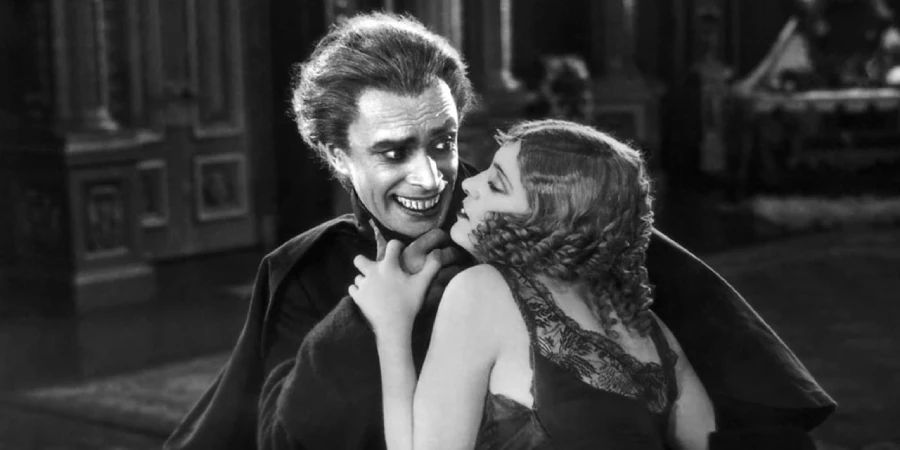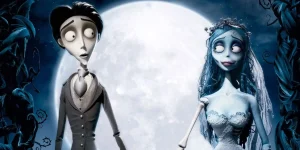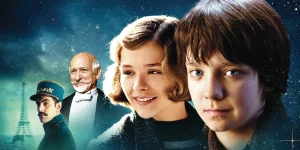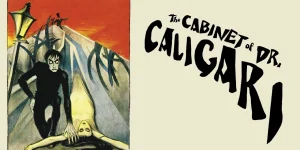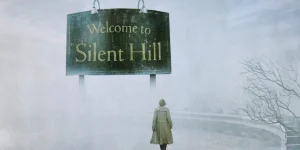The Man Who Laughs (1928) is a silent romantic drama directed by Paul Leni, based on Victor Hugo’s 1869 novel of the same name. While the film is often remembered for its haunting imagery and Conrad Veidt’s unforgettable grin, it’s more than just a gothic curiosity—it’s a tragic love story and social critique of injustice. Let’s go through it step by step.
Table of Contents
ToggleDetailed Summary
The Cruel Punishment
The movie begins in late 17th-century England under the reign of King James II. A nobleman is executed for treason, and as punishment, his young son Gwynplaine is given to the Comprachicos, a band of criminals who disfigure children. They carve a permanent grin into Gwynplaine’s face, condemning him to a life of mockery.
Abandonment and Rescue
Left to wander alone in the snow after the Comprachicos are banished, Gwynplaine discovers an abandoned baby—Dea, a blind infant. Together, they are taken in by Ursus, a traveling philosopher and carnival performer. Years later, Gwynplaine grows into a performer (played by Conrad Veidt), known across England for his terrifying yet mesmerizing grin, while Dea (Mary Philbin) grows into a young woman who loves him deeply despite never seeing his deformity.
Love, Shame, and Social Stigma
Although Dea loves Gwynplaine for who he is, Gwynplaine cannot accept her love fully. He fears her blindness means she cannot truly understand the horror of his appearance. Meanwhile, his fame draws the attention of Duchess Josiana (Olga Baclanova), a powerful and sensual aristocrat who becomes infatuated with him. Their relationship highlights the contrast between superficial desire and true love.
The Revelation of His Birthright
Eventually, it is revealed that Gwynplaine is the rightful heir to his father’s title and estates, which were taken from him unjustly. He is summoned before the House of Lords, where his disfigurement makes him an object of ridicule rather than respect. His noble identity is restored, but the humiliation he suffers underscores Hugo’s themes of injustice and class cruelty.
The Tragic Climax
Torn between his love for Dea and the temptations of Josiana, Gwynplaine ultimately chooses Dea. However, fate is merciless. After a passionate declaration of his love and identity, Gwynplaine and Dea attempt to escape together. Dea, weak and frail, collapses and dies in Gwynplaine’s arms. Overcome with grief and unable to face life without her, Gwynplaine throws himself into the sea, ending his tragic existence.
Movie Ending
The ending of The Man Who Laughs is unrelentingly tragic. Gwynplaine, who has spent his entire life mocked for his grotesque smile, finally embraces his love for Dea, who has always loved him unconditionally. But her death leaves him completely broken. In one of the most powerful moments in silent film history, Gwynplaine gazes upward in anguish before choosing death, leaping into the ocean. His permanent grin remains fixed even in despair, leaving the audience with the haunting image of a man condemned to laugh eternally while his soul weeps.
Are There Post-Credits Scenes?
No. The Man Who Laughs is a 1928 silent film, long before the concept of post-credits scenes existed. The film ends with Gwynplaine’s death at sea, and the credits roll immediately afterward.
Type of Movie
This is a silent romantic tragedy with gothic overtones. It blends elements of historical drama, melodrama, and horror imagery, especially in Gwynplaine’s disfigured visage, which later inspired the creation of the Joker character in DC Comics.
Cast
- Conrad Veidt as Gwynplaine
- Mary Philbin as Dea
- Olga Baclanova as Duchess Josiana
- Sam De Grasse as Barkilphedro
- George Siegmann as Dr. Hardquanonne
- Brandon Hurst as Lord Dirry-Moir
- Cesare Gravina as Ursus
Film Music and Composer
Since it was a silent film, live music was originally played in theaters during screenings. In 2002, composer Carl Davis created a full orchestral score for the restored version, which has since become the definitive soundtrack when the film is shown today.
Filming Locations
Filming took place at Universal Studios in Hollywood. The elaborate gothic sets and period costumes created an immersive historical England, even though it was entirely shot in the United States. The artificial, theatrical look of the film enhances its fairy-tale tragedy.
Awards and Nominations
The Man Who Laughs did not receive Academy Awards recognition—it was released before the Oscars became an established institution. However, it has since been honored in retrospectives and praised by film historians as a masterpiece of German Expressionism-influenced Hollywood cinema.
Behind the Scenes Insights
- Conrad Veidt wore prosthetics and a mechanical device to maintain the eerie grin, which was uncomfortable and sometimes painful.
- Director Paul Leni, a German émigré, infused the film with Expressionist aesthetics similar to The Cabinet of Dr. Caligari.
- The film was originally planned as a Lon Chaney vehicle, but Chaney left Universal, leading to Veidt’s casting.
- The set design heavily influenced later Universal horror films such as Frankenstein (1931).
Inspirations and References
- Based directly on Victor Hugo’s 1869 novel.
- Gwynplaine’s grotesque grin later inspired the design of the Joker’s smile in Batman.
- Paul Leni borrowed heavily from German Expressionist cinema, shaping the film’s haunting visuals.
Alternate Endings and Deleted Scenes
There are no widely known alternate endings. However, Hugo’s novel differs in one major respect: in the book, Gwynplaine also dies tragically after Dea’s death, but the sequence and circumstances are even bleaker. The film softened certain political aspects of Hugo’s critique of monarchy and aristocracy to appeal to American audiences.
Book Adaptations and Differences
Compared to the novel:
- The film emphasizes the love story between Gwynplaine and Dea, while Hugo spends more time on political satire.
- Certain side characters and subplots were removed for brevity.
- The novel is harsher on the ruling class, while the film focuses more on Gwynplaine’s personal tragedy.
Memorable Scenes and Quotes
Key Scenes
- Gwynplaine finding the abandoned baby Dea in the snow.
- Dea declaring her unconditional love, blind to his disfigurement.
- Gwynplaine humiliated in the House of Lords.
- The devastating climax where Dea dies and Gwynplaine leaps into the sea.
Iconic Quotes (Intertitles)
- “God closed my eyes so that I could see only the real Gwynplaine.” – Dea
- “The king made me a clown. Nature made me a man.” – Gwynplaine
Easter Eggs and Hidden Details
- Gwynplaine’s makeup directly foreshadows the Joker from DC Comics.
- Many of the aristocratic characters are caricatures of corruption and decadence, echoing Hugo’s satirical intentions.
- Paul Leni reused stylistic flourishes from his earlier film Waxworks.
Trivia
- The film is part of Universal’s silent gothic cycle, often considered a precursor to their monster movies.
- Paul Leni died suddenly in 1929, cutting short a promising Hollywood career.
- Mary Philbin also starred in The Phantom of the Opera (1925), another Universal silent gothic masterpiece.
Why Watch?
Because it’s one of the most visually striking and emotionally powerful silent films ever made. If you love gothic romance, tragic love stories, or want to see the direct ancestor of the Joker’s design, this film is essential. Its mix of romance, horror, and tragedy still resonates almost a century later.
Director’s Other Movies
- Waxworks (1924)
- The Cat and the Canary (1927)
- The Last Warning (1929)
Recommended Films for Fans
- The Phantom of the Opera (1925)
- Frankenstein (1931)
- Nosferatu (1922)
- The Hunchback of Notre Dame (1923)
- The Cabinet of Dr. Caligari (1920)

